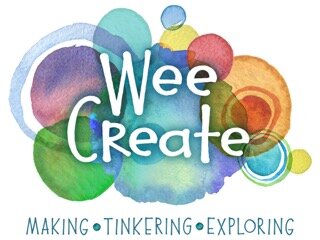At Wee Create, we offer “process-based” art experiences for kids. But what does that term even mean? And how does it benefit your child?
Simply put, process-based art means providing children with open-ended art exploration time - without the goal of a specific project. There are no step-by-step instructions or examples to follow. Rather, kids are given a range of materials and encouraged to experiment and create according to their own imagination. Each child will end up with their own unique creation, rather than trying to replicate a sample.
The focus is on organic learning - allowing kids to freely explore materials, tools, and techniques. The only rule of process-based art is that the child is enjoying the process and is in charge of their artistic expression!
This is in contrast to product-based art, where a teacher gives step-by-step instructions, teaches specific methods, and/or provides a sample meant to be copied as closely as possible.
Process-Based Art vs Product-Based Art
It’s important for young children to explore and experiment because they’re still learning how the world around them works. Process-based art allows children to discover what different materials feel like in their hands and how to manipulate tools to create specific shapes and effects. They learn what happens when they mix red and blue paint, or how to use scissors properly. Overall, children develop the confidence and skills they need for future success in both art and life.
Product-based art, on the other hand, focuses on obtaining a specific outcome. There is a final product in mind, and the goal of the experience is to replicate an example as closely as possible. (Most of the popular “children's crafts” follow this strategy.) This type of learning is best for teaching specific techniques and methods after kids have enough foundational knowledge and experience to understand how to use the materials and tools in the first place.
Benefits of Process-Based Art
Motor Skills
As kids enjoy free reign to draw, paint, glue, handle paint brushes, cut paper, tie knots, shape clay, and more, they build essential motor skills and hand-eye coordination. They learn how to manipulate tools properly and discover the outcomes they can expect from certain movements and techniques. Process-based art provides a safe and fun way to help your child develop both fine and gross motor skills that are critical for healthy childhood development.
Cognitive Development
When kids are given the freedom to express themselves creatively, their imagination grows, and they learn how to plan, solve problems, and make decisions. They also start to understand cause and effect. Process-based art encourages childrens’ natural curiosity, helping them make discoveries and express themselves in positive ways. Kids feel empowered to make choices, take risks, and embrace the unknown.
Independence
Process-based art is all about letting the child take control of their own creative process. It's a safe place for them to grow their sense of self and try a bit of independence. These critical developmental processes set them up to be adults who can act with authentic self-knowledge. They won't always need instructions and can make confident choices later on in life.
Introducing Your Child to Process-Based Art
It’s important to remember that the goal of process-based art is allowing kids to be kids and learn at their own pace. For some children, they may benefit from gentle direction or inspiration during their process-based art time. Others may work best when you are completely hands-off.
Offer a variety of supplies
Be sure to offer your kids a range of materials so they have the opportunity to make choices. The supplies should be interesting, age-appropriate, and allow your child to create freely without extensive help. Consider unusual tools such as sponges, toothbrushes, or kitchen utensils. Interesting materials such as Legos, dried beans and pasta, or colorful fall leaves can spark some wonderful imagination. You can also introduce your child to a new technique (such as collaging or potato stamping) rather than new materials. (Just remember the goal is exploration of the technique, not mastery.)
Expect a mess
Let’s be honest - when kids are having fun and freely creating, things are going to get messy. But that’s a good thing! The mess is part of the process, and the process is what allows your child to learn and grow. Take a deep breath and plan for it ahead of time. Lay down newspapers or a tarp, have wet wipes handy, or do whatever else will ensure an easier cleanup and more peace of mind.
Conclusion
“Look at life with the eyes of a child.” ~ Henri Matisse
Process-based art nurtures kids’ motor skills, cognitive development, independence, and confidence. And since it comes in the form of open-ended, educational play, kids get to be kids and have a blast while learning!
Wee Create specializes in process-based art experiences, so your child has fun with art while growing into their fullest potential. We provide a large variety of supplies, projects, and themes, so your young artists never get bored. And best of all, you get to leave the mess here when they’re finished!
Sign up for a class or workshop today!
Sources:
Tanja Mcilroy. (2023, Jan 19). Process Art for Preschoolers: Benefits & Simple Ideas. https://empoweredparents.co/process-art-for-preschoolers/
Administrator. (2023, Feb 1). What is Process Art and Why Is It Important? https://sammamishmontessori.com/what-is-process-art-and-why-is-it-important/
Anna Harpe. (2022, Dec 1). What Is Process Art? https://artfulparent.com/what-is-process-art-here-is-why-its-important-for-kids/
Messy Little Monster. (2020, Nov 16). Process Art Ideas - What Is Process Art for Kids and What Are Its Benefits? https://www.messylittlemonster.com/2020/11/process-art-for-kids.html
Mary Catherine. (2014, Mar 26). What Is Process Art for Kids and Why Is It Important? https://fun-a-day.com/process-art-for-kids/
Laurel Bongiorno. (2014, Feb/Mar edition of Teaching Young Children). https://www.naeyc.org/resources/pubs/tyc/feb2014/process-art-experiences
Henri Matisse quote found at: https://www.healing-power-of-art.org/art-and-quotes-by-famous-artists/
ChatGPT. OpenAI. (Accessed 10-24-23).


